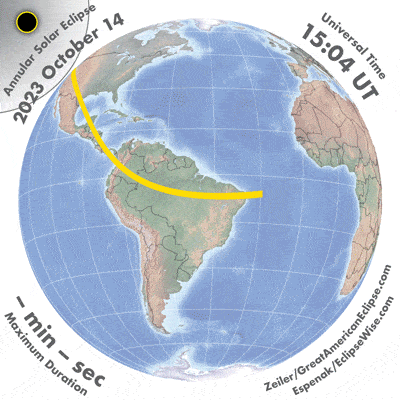Annular solar eclipse will turn the sun into a spectacular 'ring of fire' this week
With less than one week to go, the countdown to the annular solar eclipse on Oct. 14 is thoroughly underway.
On Saturday, Oct. 14, the moon will partially block the sun, creating an annular solar eclipse and turning our star into a cosmic "ring of fire."
The "ring of fire" phenomenon will be visible to those located on the 125-mile (200-kilometer) wide path of annularity that stretches from Oregon to Texas and beyond, spanning 10 countries in total. Those situated close to the path but just outside will instead experience a partial solar eclipse where the moon will appear to take a "bite" out of the sun.
Our annular eclipse 2023 guide tells you everything you need to know about the upcoming eclipse. If you want to follow along with all the eclipse action online, we have summarized some of the best free livestreams available in our how to watch the annular solar eclipse guide, NASA has also released a useful interactive map for those wanting to explore and track the eclipse down to the last second.
Related: What's the difference between a total solar eclipse and an annular solar eclipse?

If you're looking for safe optics to view the eclipse, we recommend the Celestron EclipSmart 2x Power Viewers, which have 2x magnification or this travel-friendly solar telescope. You can also consult our guide to photographing the solar eclipse.
While millions of people will be flocking to the path of annularity or viewing the event online, there will be some who avoid the annular solar eclipse altogether.
In Navajo culture, an eclipse marks a new beginning. The Navajo word for a solar eclipse jóhonaa'éí daaztsą́ means "the death of the sun" according to Navajo Traditional Teachings. During a solar eclipse, many Navajo people will remain inside, fasting and praying. When the sun returns, it's considered a rebirth and a recognized time to make resolutions. You can read more about the Navajo knowledge of the cosmos with these insightful resources from the Exploratorium.
Due to Navajo cultural beliefs surrounding the eclipse, all Navajo Tribal Parks will close from 8 a.m. to 1 p.m. MDT on Oct.14, 2023. This includes Monument Valley Navajo Tribal Park, Four Corners Monument Navajo Tribal Park and parts of the Tséyi’ Diné Heritage Area in Canyon de Chelly National Monument.
Get the Space.com Newsletter
Breaking space news, the latest updates on rocket launches, skywatching events and more!

Scientists will be using the Oct. 14 annular solar eclipse as a "warm-up" for the upcoming total solar eclipse on April 8, 2024. A solar eclipse offers atmospheric and heliospheric scientists a unique opportunity to study the sun's outer atmosphere — the corona — during the minutes that the sun is almost completely blocked by the moon.
Related: NASA’s plans to point a 34-meter telescope at America’s two upcoming solar eclipses
The two upcoming solar eclipses have scientists particularly excited as they are happening during a very active period in the current solar cycle — solar cycle 25 — as solar activity ramps up to the predicted "solar maximum" in 2024. The solar cycle describes an approximate 11-year cycle of solar activity driven by the sun's magnetic field.
Related: Where to stand in Texas to see 2 solar eclipses in under 6 months
REMEMBER to NEVER look at the sun directly. To safely view this solar eclipse you must use solar filters at all times. Whether your location will experience a partial solar eclipse or an annular solar eclipse, the dangers are the same. Observers will need to wear solar eclipse glasses, and cameras, telescopes and binoculars must have solar filters placed in front of their lenses at all times.
Our how to observe the sun safely guide tells you everything you need to know about safe solar observations.
But the eclipse action doesn't stop with the annular on Oct. 14! The "ring of fire" solar eclipse precedes a partial lunar eclipse that will occur two weeks later on Saturday, Oct. 28 and will be visible across much of the Eastern hemisphere, including Europe, Africa, Asia, Antarctica and Oceania. Lunar eclipses occur when Earth positions itself between the sun and the moon, casting a shadow across the lunar surface. During a partial lunar eclipse, only part of the moon enters Earth's shadow.
Join our Space Forums to keep talking space on the latest missions, night sky and more! And if you have a news tip, correction or comment, let us know at: community@space.com.

Daisy Dobrijevic joined Space.com in February 2022 having previously worked for our sister publication All About Space magazine as a staff writer. Before joining us, Daisy completed an editorial internship with the BBC Sky at Night Magazine and worked at the National Space Centre in Leicester, U.K., where she enjoyed communicating space science to the public. In 2021, Daisy completed a PhD in plant physiology and also holds a Master's in Environmental Science, she is currently based in Nottingham, U.K. Daisy is passionate about all things space, with a penchant for solar activity and space weather. She has a strong interest in astrotourism and loves nothing more than a good northern lights chase!









